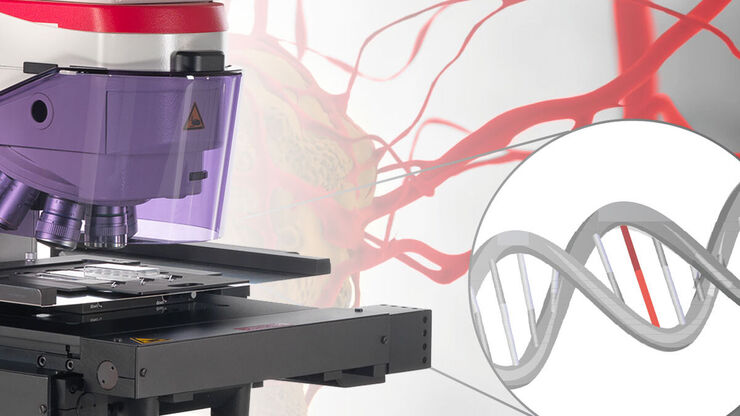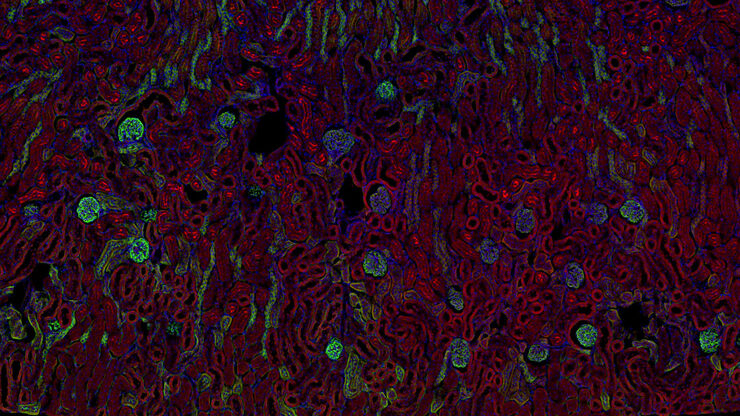Filter articles
标签
产品
Loading...

用大数据视角深入了解胰腺癌研究
胰腺癌由于其靠近主要器官难以分辨和难治疗,死亡率接近 40%,。这个研究探讨了胰腺导管腺癌(PDAC)的复杂生物学机制,研究了代谢、凋亡和免疫中肿瘤侵袭性的相关分子结构和空间决定因素。可以访问您的浏览器中的完整 Cell DIVE 数据集,以深入了解这些发现。
Loading...

利用大数据查看器揭示结肠癌隐藏的复杂性
结直肠癌是一种的重大健康负担。虽然手术初期有效,但部分患者会发展为预后不良的复发性继发疾病,需要采用免疫疗法等先进治疗手段。利用空间生物学方法,如 Cell DIVE 多重成像技术,可为开发新型治疗方案提供关键洞见。通过 Minerva 图像查看器在浏览器中访问完整的 Cell DIVE 数据集,进一步探索这些发现。
Loading...

利用人工智能驱动的空间蛋白质组学绘制肿瘤免疫图谱
未经治疗肿瘤的空间图谱分析可呈现肿瘤免疫结构的整体特征,有助于理解治疗反应。具有免疫活性的小鼠模型对于识别肿瘤发生发展过程中免疫依赖性事件至关重要。要表征这些具有完整免疫系统及相互作用细胞组分的模型,需要采用多重标记分析技术。我们展示了一种基于人工智能的空间蛋白质组学方法,用于研究小鼠癌组织中的肿瘤-免疫互作机制。
Loading...

组织中的精密空间蛋白质组学信息
尽管可使用基于成像和质谱的方法进行空间蛋白质组学研究,但是图像与单细胞分辨率蛋白丰度测量值的关联仍然是个巨大的挑战。最近引入的一种方法,深层视觉蛋白质组学(DVP),将细胞表型的人工智能图像分析与自动化的单细胞或单核激光显微切割及超高灵敏度的质谱分析结合在了一起。DVP在保留空间背景的同时,将蛋白丰度与复杂的细胞或亚细胞表型关联在一起。
Loading...

阿尔茨海默病神经免疫相互作用的空间分析
阿尔茨海默病(AD)是一种复杂的神经退行性疾病,以神经原纤维缠结、β-淀粉样斑块和神经炎症为特征。这些功能障碍由局部免疫反应触发或加剧。因此,在空间背景下理解神经免疫相互作用对于阐明 AD 发病机制至关重要。本研究采用 Cell DIVE 多重成像技术和 Aivia 人工智能辅助空间分析工具,探究 AD 病理标志物周围免疫细胞的特征。
Loading...

使用空间多重化探测人类阿尔茨海默病皮层切片
阿尔茨海默病(AD)是最常见的神经退行性疾病,其特征是认知功能的逐渐下降。对 AD 大脑的空间分析可能揭示细胞关系,从而促进对疾病病因的更好理解。本研究捕捉了 AD 皮层组织成分的全球概述,并强调了 Cell DIVE 成像的简化工作流程,从数据采集到使用 Aivia 软件的基于人工智能的分析,最终实现更快的洞察。
Loading...

您的 3D 类器官成像和分析工作流程效率如何?
类器官模型已经改变了生命科学研究,但优化图像分析协议仍然是一个关键挑战。本次网络研讨会探讨了类器官研究的简化工作流程,首先是实时的三维细胞培养检查,接下来是高速、高分辨率的三维成像,生成清晰的图像和更纯净的数据,以便对生长速率、细胞迁移和三维细胞相互作用等参数进行准确地人工智能分割和量化,从而实现更深入的洞察。



